The purpose of a storm manhole is to allow for a human access point at certain intervals of a storm drainage system for inspection and maintenance purposes. Manholes are typically found on most streets, highways, and busy roads. Storm manholes are used in conjunction with catch basins are engineered to move storm precipitation (non-treated) into larger bodies of water. A majority of common day storm sewer manholes are made of steel reinforced or non-reinforced precast concrete, but there are also brick and mortar, plastic, and polymer type manholes. The middle and earlier 20th century was known mostly for brick and mortar catch basins. The typical common day storm manhole is made of concrete precast in a plant specializing in such work where their equipment is specifically tailored for precast structures.

A precast manhole is typically formed, cast, cured, and stripped in an indoor controlled environment to maximize strength and performance. Specialized steel and aluminum forms have become the standard as they provide good results and can be used many times before disposal.
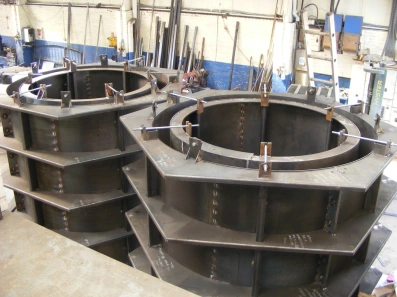
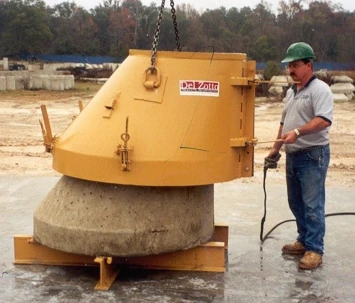
Manholes are most commonly round but may be square or rectangular as well. Storm manholes typically have metal, fiberglass, or polypropylene steps cast into the concrete for interior access. Polypropylene steps typically have a steel interior giving them strength. The typical attachment method at the factory is pre-drilling holes in the precast structure and tapping the steps into the holes securing them.

A manhole is typically made of 2 or more pieces:
-the base (or base/riser combo)
-the riser (can be several pieces depending on depth)
-top (eccentric cone, concentric cone, or flat-top)
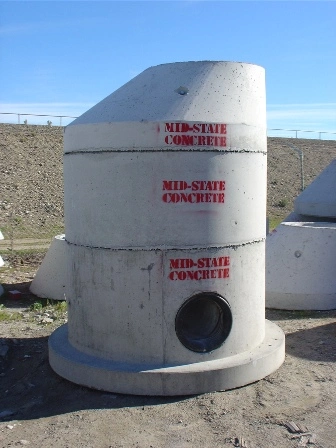
Cone pieces are very commonly eccentric for sanitary manholes, but can be centered as well. Cone sections are typically available as stock in 24”, 32”, 36”, and 48” heights. Eccentric cone top’s radii typically taper from 48” to 24” but other sizes are available as well. A coned top is more useful when a pipe, road pavement section, or obstruction must be avoided thus allowing the coned top to be offset not infringing on the adjacent obstruction.

Flat tops are useful for manholes without adjacent pipes, obstructions, or roads hindering the top placement. Their hole in the top can be either eccentric or centered. Flat tops are typically available in square or round 12” or 16” thicknesses, but special sizes may be available.
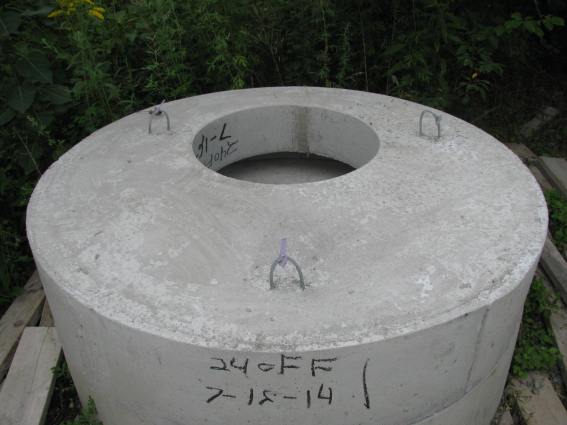
Riser sections are typically available as stock in 16”, 32”, 48”, and 64” lengths.
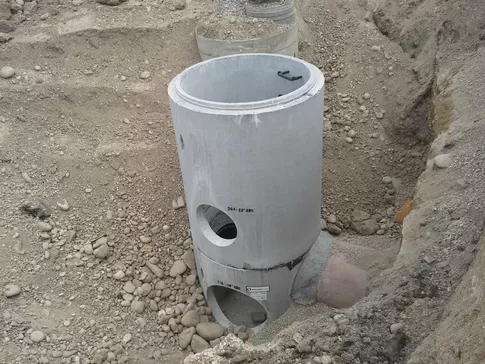
After a manhole is cast (if formouts were not utilized) holes are cored at pre-calculated elevations, angles, and sizes to allow for pipe penetrations.

The vertical elevations assigned to the bottom of the inside of the inlet and outlet pipe penetrations are referred to as the ‘invert’ elevation. ‘Shop drawings’ are usually sent to be reviewed by the engineer to assure everything is correct prior to fabrication. The more accurate the shop drawings, the fewer field adjustments must be made and the smoother the field installation will be. Shop drawings will commonly include:
-Manhole profile and structure type
-Type of pipe used
-Pipe opening sizes, locations, invert elevations, and plan view angles
-Base, riser, and top sections utilized
-Rim elevation
The invert elevations are a critical part of the entire gravity flow system dictating how storm water will flow. This is typically designed by the engineer and the cored holes must be placed accurately (vertically, horizontally, and at the correct skew) by the precast manufacturer.
For storm manholes, inverts are commonly formed and poured in the field prior to or after manhole installation, though they can be precast with the supplier. Another purpose of the invert is to help in the flow of water and to avoid flow interruption.
Storm manholes pipe penetrations are commonly filled with brick or block pieces, and grouted on the inside and outside to seal out as much groundwater as possible.The material utilized most commonly non-shrink hydraulic grout.

Storm manhole pipe penetrations do not commonly receive a booted connection unless an engineer specifically requires them. If used, these boots are commonly provided and installed by the manhole manufacturer prior to shipment to the jobsite. These boots commonly have a stainless steel band which is tightened around the pipe connection during manhole installation. Sometimes the manufacturer will ship the boot with a stub of pipe pre-installed so a belled connection can be made.


A manhole will typically have a ‘casting’ on top of the manhole itself which is essentially a cast iron lid allowing access and durable enough to last through weather and traffic for decades before requiring replacement.

There are all kinds of casting frames and lids types available: gasketed, vented, solid, grated etc Storm manholes typically utilize vented, slotted, or grated lids. The casting is commonly grouted or mortared to the top of the manhole structure and sometimes the engineer will even require they be bolted down.



One of the more common manhole sizes is 48” inside diameter with a 60” outside diameter, but it is not uncommon to see inside diameter sizes of 5′, 6′, 7′, 8′ or larger depending on the type of pipe (wall thickness), size of the pipe, pipe skew, and connection type (grouted or booted).
The following is a rule of thumb for corrugated HDPE pipe and associated required minimum inside diameter of manhole based on limited skew ad no booted connection:

Concrete pipe has thicker walls than corrugated HDPE or SDR35 pipe, hence the inside diameter of manholes will generally be larger to accommodate. Extreme pipe skew angles and booted connections will also typically drive up the minimum inside manhole diameter requirements. 4′ diameter storm manholes (not shown above) can typically accept up to 30″ SDR35 or HDPE diameter pipe with no booted connections or extreme pipe skews.
Storm sewer manhole depths on average are typically shallower than sanitary manholes at a common depth range of 2’ to 10’ but deeper systems are required in some situations.
Precast manholes are commonly delivered on a commercial truck with flatbed trailer. Some of the trucks are equipped with a hydraulic boom which can self unload.
A standard boom truck for offloading precast structures will usually max out at approximately 16000lbs (8 tons) per lift but each supplier or trucking firm will be able to provide their maximum lifting capacity upon request.
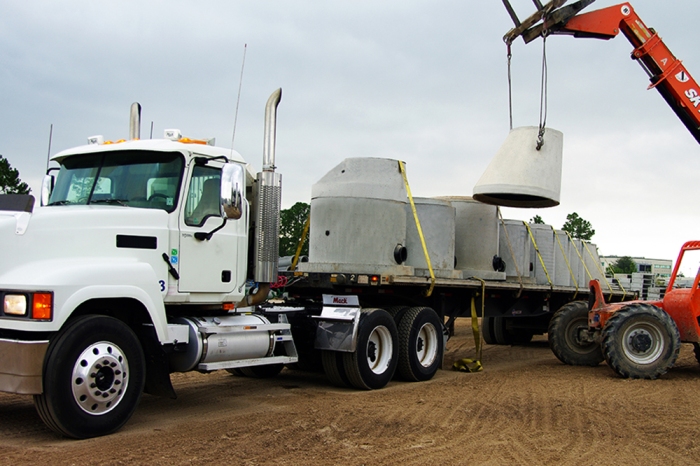
If no self-unloading truck is utilized the pieces must be removed from the trailer bed with an excavator, backhoe, crane, or forklift. The type of rigging attachment’s provided by precast manufacturers can vary widely. Some provide cast-in loops on the exterior or interior. Others provide ‘lift-holes’ which are just openings in the structure where chains or cables can be passed through for lifting. The lift holes are typically placed near the center of gravity if possible, so the structure can be lifted with only one hoist and not be in danger of turning or spinning.

The typical crew required for installing a standard sized manhole consists of 4-5 workers: 2 operators, 1-2 laborers, and a foreman. The equipment required will be a backhoe or excavator rated to lift the heaviest piece of the manhole and a front end loader to move and place bedding and backfill material into the excavation. The excavation is then typically bedded with 4-12″ course or well-graded aggregate. The typical aggregate gradation used for bedding follows the following sieve analysis: 100% passing 1” sieve, 90-100% passing ¾” sieve, 20-55% passing ½” sieve, 0-15% passing 3/8” sieve, 0-5% passing 4.75mm sieve. The purpose of the bedding is to provide a stable working platform and to provide a subgrade that will not shift or move the structure before or after installation.

The hole where the manhole will be placed is excavated large enough for the workers to install pipe into the manhole. In situations deeper than 4-5 feet or when ‘stepping back of the excavation isn’t possible or practical, a ‘manhole box’ or other trench shoring system is utilized

Once the approximate depth is calculated and excavated, the backhoe operator will pick up the manhole base with chains or slings with anchor points on the manhole and slowly lower it into the hole. There will be 1-2 workers in the hole to receive and guide the manhole base into place.

Care should be taken for the workers to never be underneath a structure piece as it is being lowered into position. Once the base section is in the correct position, the next step is to lower and interlock the riser section (or sections) onto the base. Due to the depths of sanitary manholes, it is common for many riser sections to be required to achieve the required depth of the manhole. It is typical for a mastic product to be applied to the base and each riser section to help limit water infiltration/exfiltration throughout the life of the manhole. Though more common with sanitary manholes, premoulded strips may be required between each section.
Lastly the top is lowered and placed above the riser. An adjustment or ‘grade ring’ is commonly installed between the top of the precast basin and the casting. Essentially the function of a grade ring is to allow final minor adjustments in the elevation of the casting upon established the finish grade which will surround the casting. Grade rings typically come from 1” to 6” thick and can be circular or square in shape. A mastic material or mortar is commonly installed between grade rings themselves and between the top of the structure.
There is usually a limit placed by engineers of +/- 12″ on the amount of grade rings that can be installed before an actual riser section will be required.
Once the final elevation has been achieved and the manhole is permanently set in place horizontally and vertically, the excavated area surrounding the manhole is backfilled. For storm manholes, it is common for the inner area from the bottom of casting to the top of the precast structure to be mortared smooth to limit groundwater infiltration/exfiltration. Also the pipe penetration joints at the interior of the structure must be mortared/grouted solid to limit infiltration/exfiltration as well.

Lastly, depending on whether the manhole is within an area with vehicle traffic, a ‘concrete collar’ may be required.

This is typically the last task done when installing a manhole. A concrete collar is a cast in place concrete section formed and poured around the casting giving additional strength and reinforcement to the catch basin from vehicle traffic. The concrete collar also helps resist the entire assembly from shifting or moving with vehicle traffic or freeze thaw conditions.
In a new road or road reconstruction condition, sometimes the manhole castings are paved over with asphalt and the asphalt is later removed allowing for the collar to then be poured. In this situation the collar is either chipped out by hand with a jackhammer, or cored with a mechanical coring attachment.
This approach is considered by many the simplest way to pave a road and in turn place the collars. For areas subject to vehicle traffic, it is common for an accelerated cure time concrete mix to be used to allow for vehicle traffic soon after placement.








